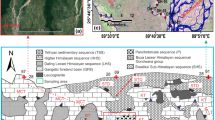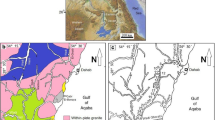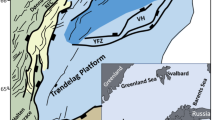Abstract
The present research deals with the FEG-EPMA mapping and Fe-Ti oxide mineral chemistry of Brahmaputra River sediments in Bangladesh. Major heavy minerals in the sediments consist of garnet (8.5–21.3%), kyanite (5.35–11.9%), monazite (2.3–5.3%), sillimanite (1.8–4.7%), zircon (3.6–9.1%), and a considerable amount of opaques mainly Fe-Ti oxide minerals (23.1–35.4%). The detrital Fe-Ti oxide minerals carry significant clues to the parent rocks or sources. In these contexts, detrital opaques (Fe-Ti oxides) have been analyzed with an electron probe microanalyzer (EPMA). These opaques (Fe-Ti oxide) display six types of textural patterns, dominantly seriate with granular, emulsion, and acicular sandwich structures and trellis type of textural patterns. These textural patterns belong to five intergrowths of Fe-Ti oxide minerals such as (1) ilmenite-hematite, (2) magnetite-ilmenite, (3) hematite-rutile, (4) ilmenite-hematite-rutile, and (5) ilmenite-rutile, where ilmenite-hematite intergrowth is common. Alteration is seen in both exsolved and unexsolved ilmenites. Textural patterns and mineral chemistry of the studied ilmenite minerals provide lines of evidence of low-temperature magmatic inheritance, later modified by diffusional processes. The estimated temperature and oxygen fugacity from the magnetite-ilmenite exsolution range from 547.6 to 558.2 °C and from 10−21.4 to 10−21.7, respectively. The data are also consistent with hematite-ilmenite temperature (between 537 and 540 °C) and oxygen fugacity (10−21.7 to 10−21.9) measurements in Cox’s Bazar beach placers. These temperatures and oxygen fugacities specify Fe-Ti oxide assemblages equilibrated in a T-fO2 field very near to the FMQ buffer curve suggesting a crustal source (magmatic and/or metamorphic), which is modified significantly by metamorphic processes.








Similar content being viewed by others
References
Amini A, Anketell JM (2015) Textural and geochemical studies of detrital Fe–Ti oxides and test of their validity in provenance determination, a case study from Central Iran. J Afr Earth Sci 103:140–152
Basu A, Molinaroli E (1989) Provenance characteristics of opaque Fe–Ti oxide minerals. J Sediment Petrol 59:922–934
Basu A, Molinaroli E (1991) Reliability and application of detrital opaque Fe–Ti oxide minerals in provenance determination. In: Morton AC, Todd SP, Haughton PDW (Eds) Development in sedimentary provenance studies. Geol Soc London 57:55-65
Braun E, Raith M (1985) Fe-Ti oxides in metamorphic basites from the eastern Alps, Austria: a contribution to the formation of solid solutions of natural Fe-Ti oxide assemblages. Contrib Mineral Petrol 90:199–213
Brownlee SJ, Feinberg JM, Harrison RJ, Kasama T, Scott GR, Renne PR (2010) Thermal modification of hematite-ilmenite intergrowths in the Ecstall pluton, British Columbia, Canada. Am Mineral 95:153–160
Buddington AF, Lindsley DH (1964) Iron-titanium oxide minerals and synthetic equivalents. J Petrol 5:310–357
Cassidy KF, Groves DI, Binns RA (1988) Manganoan ilmenite formed during regional metamorphism of Archean mafic and ultramafic rocks from western Australia. Can Mineral 26:999–1012
Cawthorn RG, Groves DI, Marchant T (1985) Magnesian ilmenite: clue to high-Mg parental magma of the Insizwa Complex, Transkei. Can Mineral 23:609–618
Clark MK, Bilham R (2008) Miocene rise of the Shillong Plateau and the beginning of the end for the eastern Himalaya. Earth Planet Sci Lett 269:337–351
Deer WA, Howie RA, Zussman J (1992) An introduction to rock forming minerals, 2nd edn. Longman, Harlow, Wiley, New York
Droop GTR (1987) A general equation for estimating Fe3+ concentration in ferromagnesian silicates and oxides from microprobe analysis using stoichiometric criteria. Mineral Mag 51:431–435
Dupuis C, Beaudoin G (2011) Discriminant diagrams for iron oxide trace element fingerprinting of mineral deposit types. Mineral Deposita 46:319–335
Frost BR (1991) Magnetic petrology: factors that control the occurrence of magnetite in crustal rocks. Rev Mineral Geochem 25:489–509
Frost BR, Lindsley DH (1991) Occurrence of iron-titanium oxides in igneous rocks. In: Lindsley DH (Ed) Oxide minerals: petrologic and magnetic significance. Rev Mineral 25:433-468
Frost MT, Grey IE, Harrowfield IR, Mason K (1983) The dependence of alumina and silica contents on the extent of alteration of weathered ilmenites from western Australia. Mineral Mag 47:201–208
Gill JB (2011) Orogenic andesites and plate tectonics. Vol 16 of minerals, rocks and mountains. Springer, Berlin
Goscombe B, Gray D, Hand M (2006) Crustal architecture of the Himalayan metamorphic front in eastern Nepal. Gondwana Res 10:232–255
Grey IA, Reid AF (1975) The structure of pseudorutile and its role in the natural alteration of ilmenite. Am Mineral 60:898–906
Grey IE, Li C, Watts AJ (1983) Hydrothermal synthesis of goethite-rutile intergrowth structures and their relationship to pseudorutile. Am Mineral 68:981–988
Haggerty SE (1976) Opaque oxide minerals in terrestrial igneous rocks. In: Oxide Minerals MSA Short Course Notes. 3: 101–3011
Haggerty SE (1991) Oxide textures: a mini atlas. In: Lindsley DH (Ed) Oxide minerals: petrologic and magnetic significance. Rev Mineral 25:129-219
Heroy DC, Kuehl SA, Goodbred SL (2003) Mineralogy of the Ganges and Brahmaputra Rivers: implications for river switching and Late Quaternary climate changes. Sediment Geol 155:343–359
Hugo VE, Cornell DH (1991) Altered ilmenites in Holocene dunes from Zululand, South Africa: petrographic evidence for multistage alteration. S Afr J Geol 94(5–6):365–378
Lattard D (1995) Experimental evidence for the exsolution of ilmenite from titaniferous spinel. Am Mineral 80:968–981
Lipman PW (1971) Iron-titanium oxide phenocrysts in compositionally zoned ash-flow sheets from southern Nevada. J Geol 79:438–456
Miicke A, Annor A (1993) Examples and genetic significance of the formation of iron oxides in the Nigerian banded iron-formations. Mineral Deposita 28:136–145
Mitra S, Ahmed SS (1990) Exsolution characters of ilmenite placers around the Bay of Bengal and their genetic relevance (abstr). Proceeding of International Mineralogical Association Meeting (Third General), Beijing
Mitra S, Ahmed SS, Moon H (1992) Mineralogy and chemistry of the opaques of Cox’s Bazar (Bangladesh) beach sands and the oxygen fugacity of their provenance. Sediment Geol 77:235–247
Mohapatra S, Behera P, Das SK (2015) Heavy mineral potentiality and alteration studies for ilmenite in Astaranga Beach sands, District Puri, Odisha, India. J Geosci Envir Protect 3:31–37
Neumann ER (1974) The distribution of Mn2+ and Fe2+ between ilmenites and magnetites in igneous rocks. Am J Sci 274:1074–1088
Powell R, Powell M (1977) Geothermometry and oxygen barometry using coexisting iron-titanium oxides: a reappraisal. Mineral Mag 41:257–263
Putnis A (1978) The mechanism of exsolution of hematite from iron-bearing rutile. Phys Chem Miner 3:183–197
Rahman MA, Biswas PK, Zaman MN, Miah MY, Hossain T, Huq SMI (2012) Characterisation of the sand of Brahmaputra river of Bangladesh. Bangladesh J Sci Indus Res 47:167–172
Reynolds IM (1983) The iron-titanium oxide mineralogy of Karoo dolerite in the eastern Cape and southern Orange Free State. Trans Geol Soc S Afr 86:211–220
Riezebos PA (1979) Compositional downstream variation of opaque and translucent heavy residues in some modern Rio Magnalena sands (Columbia). Sediment Geol 24:197–225
Rollinson HR (1980) Mineral reactions in a granulite facies calc-silicate rock from Scourie. Scott J Geol 16(2–3):153–164
Sauerzapf U, Lattard D, Burchard M, Engelamann R (2008) The titanomagnetite-ilmenite equilibrium: new experimental data and thermo-oxybarometric application to the crystallization of basic to intermediate rocks. J Petrol 49:1161–1185
Spencer KJ, Lindsley DH (1981) A solution model for coexisting iron-titanium oxides. Am Mineral 66:1189–1201
Thompson RN (1976) Chemistry of ilmenites crystallized within the anhydrous melting range of a tholeiitc andesite at pressures between 5 and 26 kb. Mineral Mag 40:857–862
Valdiya KS (2002) Emergence and evolution of Himalaya: reconstructing history in the light of recent studies. Prog Phys Geogr 26:360–399
Wilson NC, MacRae CM (2005) An automated hybrid clustering technique applied to spectral data sets. Microsc Microanal 11(Suppl 2):434CD
Woodsworth GJ (1977) Homogenization of zoned garnets from palitic schists. Can Mineral 15:230–242
Acknowledgments
The authors cordially thank Mark I. Pownceby (co-worker at CSIRO, Australia) for his great contribution to carry out the XRD and EPMA data from the laboratory housed in CSIRO, Australia. The authors are extremely grateful to other scientists, technicians, and other laboratory attendants of the Institute of Mining, Mineralogy and Metallurgy (IMMM) for their help during sample collection, preparation, and analytical services. The authors are also grateful to the anonymous reviewers for their constructive reviews and comments.
Funding
The authors acknowledge the financial support in the form of research fellowship (Professor Mofizuddin Ahmed Sriti Fellowship, Bangladesh Council of Scientific and Industrial Research) provided by the Ministry of Science and Technology, Bangladesh, and also the Chairman of BCSIR for supporting the laboratory’s equipment.
Author information
Authors and Affiliations
Corresponding author
Rights and permissions
About this article
Cite this article
Hasan, A.S.M.M., Hossain, I., Rahman, M.A. et al. FEG-EPMA mapping and Fe-Ti oxide mineral chemistry of Brahmaputra River sediments in Bangladesh: provenance and petrogenetic implications. Arab J Geosci 11, 567 (2018). https://doi.org/10.1007/s12517-018-3905-8
Received:
Accepted:
Published:
DOI: https://doi.org/10.1007/s12517-018-3905-8




